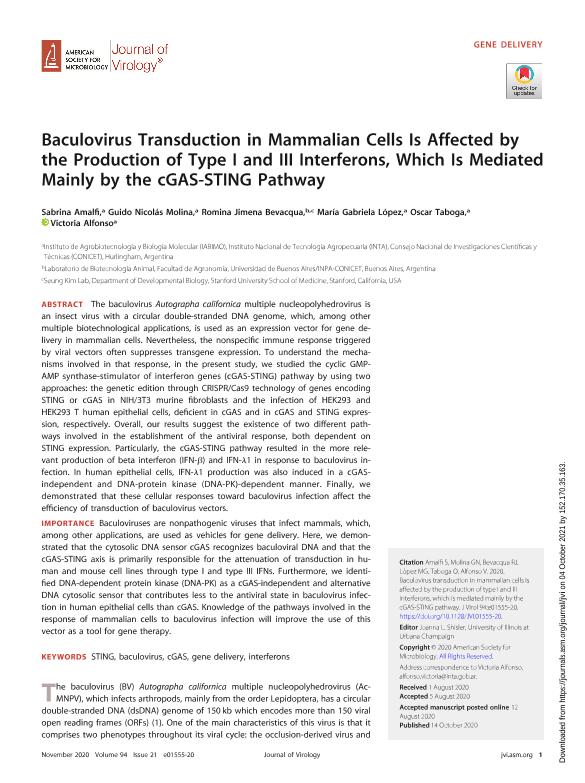Mostrar el registro sencillo del ítem
dc.contributor.author
Amalfi, Sabrina

dc.contributor.author
Molina, Guido Nicolás

dc.contributor.author
Bevacqua, Romina Jimena

dc.contributor.author
López, María Gabriela

dc.contributor.author
Taboga, Oscar Alberto

dc.contributor.author
Alfonso, Victoria

dc.date.available
2021-10-04T14:01:39Z
dc.date.issued
2020-10
dc.identifier.citation
Amalfi, Sabrina; Molina, Guido Nicolás; Bevacqua, Romina Jimena; López, María Gabriela; Taboga, Oscar Alberto; et al.; Baculovirus Transduction in Mammalian Cells Is Affected by the Production of Type I and III Interferons, Which Is Mediated Mainly by the cGAS-STING Pathway; American Society for Microbiology; Journal of Virology; 94; 21; 10-2020; 1-16
dc.identifier.issn
0022-538X
dc.identifier.uri
http://hdl.handle.net/11336/142433
dc.description.abstract
The baculovirus Autographa californica multiple nucleopolyhedrovirus is an insect virus with a circular double-stranded DNA genome, which, among other multiple biotechnological applications, is used as an expression vector for gene delivery in mammalian cells. Nevertheless, the nonspecific immune response triggered by viral vectors often suppresses transgene expression. To understand the mechanisms involved in that response, in the present study, we studied the cyclic GMP-AMP synthase-stimulator of interferon genes (cGAS-STING) pathway by using two approaches: the genetic edition through CRISPR/Cas9 technology of genes encoding STING or cGAS in NIH/3T3 murine fibroblasts and the infection of HEK293 and HEK293 T human epithelial cells, deficient in cGAS and in cGAS and STING expression, respectively. Overall, our results suggest the existence of two different pathways involved in the establishment of the antiviral response, both dependent on STING expression. Particularly, the cGAS-STING pathway resulted in the more relevant production of beta interferon (IFN-β) and IFN-λ1 in response to baculovirus infection. In human epithelial cells, IFN-λ1 production was also induced in a cGAS-independent and DNA-protein kinase (DNA-PK)-dependent manner. Finally, we demonstrated that these cellular responses toward baculovirus infection affect the efficiency of transduction of baculovirus vectors. IMPORTANCE Baculoviruses are nonpathogenic viruses that infect mammals, which, among other applications, are used as vehicles for gene delivery. Here, we demonstrated that the cytosolic DNA sensor cGAS recognizes baculoviral DNA and that the cGAS-STING axis is primarily responsible for the attenuation of transduction in human and mouse cell lines through type I and type III IFNs. Furthermore, we identified DNA-dependent protein kinase (DNA-PK) as a cGAS-independent and alternative DNA cytosolic sensor that contributes less to the antiviral state in baculovirus infection in human epithelial cells than cGAS. Knowledge of the pathways involved in the response of mammalian cells to baculovirus infection will improve the use of this vector as a tool for gene therapy.
dc.format
application/pdf
dc.language.iso
eng
dc.publisher
American Society for Microbiology

dc.rights
info:eu-repo/semantics/openAccess
dc.rights.uri
https://creativecommons.org/licenses/by-nc-sa/2.5/ar/
dc.subject
BACULOVIRUS
dc.subject
CGAS
dc.subject
GENE DELIVERY
dc.subject
INTERFERONS
dc.subject
STING
dc.subject.classification
Virología

dc.subject.classification
Ciencias Biológicas

dc.subject.classification
CIENCIAS NATURALES Y EXACTAS

dc.title
Baculovirus Transduction in Mammalian Cells Is Affected by the Production of Type I and III Interferons, Which Is Mediated Mainly by the cGAS-STING Pathway
dc.type
info:eu-repo/semantics/article
dc.type
info:ar-repo/semantics/artículo
dc.type
info:eu-repo/semantics/publishedVersion
dc.date.updated
2021-09-07T14:58:44Z
dc.journal.volume
94
dc.journal.number
21
dc.journal.pagination
1-16
dc.journal.pais
Estados Unidos

dc.description.fil
Fil: Amalfi, Sabrina. Instituto Nacional de Tecnología Agropecuaria. Centro de Investigación En Ciencias Veterinarias y Agronómicas. Instituto de Agrobiotecnología y Biología Molecular. Consejo Nacional de Investigaciones Científicas y Técnicas. Oficina de Coordinación Administrativa Parque Centenario. Instituto de Agrobiotecnología y Biología Molecular; Argentina
dc.description.fil
Fil: Molina, Guido Nicolás. Instituto Nacional de Tecnología Agropecuaria. Centro de Investigación En Ciencias Veterinarias y Agronómicas. Instituto de Agrobiotecnología y Biología Molecular. Consejo Nacional de Investigaciones Científicas y Técnicas. Oficina de Coordinación Administrativa Parque Centenario. Instituto de Agrobiotecnología y Biología Molecular; Argentina
dc.description.fil
Fil: Bevacqua, Romina Jimena. Consejo Nacional de Investigaciones Científicas y Técnicas. Oficina de Coordinación Administrativa Parque Centenario. Unidad Ejecutora de Investigaciones en Producción Animal. Universidad de Buenos Aires. Facultad de Ciencias Veterinarias. Unidad Ejecutora de Investigaciones en Producción Animal; Argentina
dc.description.fil
Fil: López, María Gabriela. Instituto Nacional de Tecnología Agropecuaria. Centro de Investigación En Ciencias Veterinarias y Agronómicas. Instituto de Agrobiotecnología y Biología Molecular. Consejo Nacional de Investigaciones Científicas y Técnicas. Oficina de Coordinación Administrativa Parque Centenario. Instituto de Agrobiotecnología y Biología Molecular; Argentina
dc.description.fil
Fil: Taboga, Oscar Alberto. Instituto Nacional de Tecnología Agropecuaria. Centro de Investigación En Ciencias Veterinarias y Agronómicas. Instituto de Agrobiotecnología y Biología Molecular. Consejo Nacional de Investigaciones Científicas y Técnicas. Oficina de Coordinación Administrativa Parque Centenario. Instituto de Agrobiotecnología y Biología Molecular; Argentina
dc.description.fil
Fil: Alfonso, Victoria. Instituto Nacional de Tecnología Agropecuaria. Centro de Investigación En Ciencias Veterinarias y Agronómicas. Instituto de Agrobiotecnología y Biología Molecular. Consejo Nacional de Investigaciones Científicas y Técnicas. Oficina de Coordinación Administrativa Parque Centenario. Instituto de Agrobiotecnología y Biología Molecular; Argentina
dc.journal.title
Journal of Virology

dc.relation.alternativeid
info:eu-repo/semantics/altIdentifier/url/https://jvi.asm.org/content/early/2020/08/07/JVI.01555-20.abstract
dc.relation.alternativeid
info:eu-repo/semantics/altIdentifier/doi/http://dx.doi.org/10.1128/JVI.01555-20
Archivos asociados
